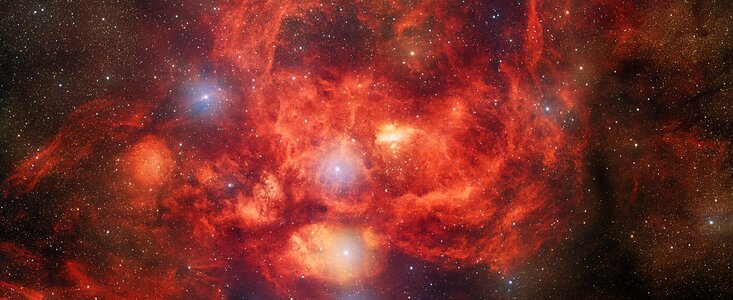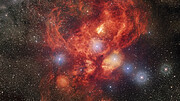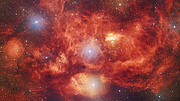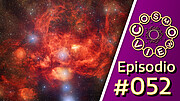Dark Energy Camera Captures Bright, Young Stars Blazing Inside Glowing Nebula
To celebrate 10 years of discovery, the DOE-built DECam unveils thousands of stars shining in and around the Lobster Nebula
12 September 2022
The 570-megapixel US Department of Energy-fabricated Dark Energy Camera at NOIRLab’s Cerro Tololo Inter-American Observatory in Chile is one of the most powerful tools in astronomy and astrophysics. To commemorate its first decade of discovery and exploration, NOIRLab has released a stunning image of the Lobster Nebula, a brilliant star-forming region located 8000 light-years from Earth in the direction of the constellation Scorpius. The image was unveiled at a conference highlighting DECam’s breakthrough science results.
The Dark Energy Camera (DECam) mounted on the Víctor M. Blanco 4-meter Telescope at Cerro Tololo Inter-American Observatory in Chile, a Program of NSF’s NOIRLab, is celebrating 10 years as one of the highest-performance, wide-field CCD imagers in the world.
To help commemorate DECam’s first decade of operation, NOIRLab has released a breathtaking image of the star-forming Lobster Nebula (NGC 6357), which is located about 8000 light-years from Earth in the direction of the constellation Scorpius. This image reveals bright, young stars surrounded by billowing clouds of dust and gas.
At the center of the nebula, which spans about 400 light-years, resides the open star cluster Pismis 24 — a collection of dazzlingly bright, massive stars. Surrounding this cluster is a region brimming with newborn stars, protostars still wrapped in their cocoons of star-forming material, and dense cores of gas and dust that will eventually become new stars. The twisting braids of dark clouds and complex structures inside the nebula are formed by the tumultuous pressure of interstellar winds, radiation, and powerful magnetic fields.
One of the most striking things about this image is the beautifully detailed color palette selected to highlight different aspects of the nebula. This wide-field, high-resolution image showcases the power of DECam and its ability to produce stunning images while helping astronomers study the fundamental properties of the Universe.
This image was constructed using some of a new range of very special DECam narrowband filters, which isolate very specific wavelengths of light. They make it possible to infer the physics of distant objects, including important details about their inner motions, temperatures, and complex chemistry, which is especially important when examining star-forming regions like the Lobster Nebula.
In order to create a colorful image such as this one, the same celestial object is observed multiple times using different filters. Each observation provides a single-color image, which encompasses a specific range of light waves. Imaging specialists then take these individual images and assign a corresponding color to each of them. The images can then be stacked on top of one another to create a composite that closely approximates what objects might look like if they were far brighter.
The image was unveiled at the DECam at 10 years: Looking Back, Looking Forward conference, which highlighted the outstanding DECam science results of the past 10 years and the exciting opportunities with DECam as astronomy looks to the future with Vera C. Rubin Observatory, currently under construction on Cerro Pachón in Chile. DECam has just passed the remarkable milestone of taking one million individual exposures, delivering on average 400 to 500 images per night.
DECam was operated by the DOE and NSF between 2013 and 2019. DECam was funded by the DOE and was built and tested at DOE's Fermilab. Currently, DECam is used for programs covering a huge range of science.
The image was obtained by NOIRLab’s Communication, Education & Engagement team as part of the NOIRLab Legacy Imaging Program.
More information
NSF’s NOIRLab(National Optical-Infrared Astronomy Research Laboratory), the US center for ground-based optical-infrared astronomy, operates the International Gemini Observatory(a facility of NSF, NRC–Canada, ANID–Chile, MCTIC–Brazil, MINCyT–Argentina, and KASI–Republic of Korea), Kitt Peak National Observatory (KPNO), Cerro Tololo Inter-American Observatory (CTIO), the Community Science and Data Center (CSDC), and Vera C. Rubin Observatory(operated in cooperation with the Department of Energy’s SLACNational Accelerator Laboratory). It is managed by the Association of Universities for Research in Astronomy (AURA) under a cooperative agreement with NSF and is headquartered in Tucson, Arizona. The astronomical community is honored to have the opportunity to conduct astronomical research on Iolkam Du’ag (Kitt Peak) in Arizona, on Maunakea in Hawai‘i, and on Cerro Tololo and Cerro Pachón in Chile. We recognize and acknowledge the very significant cultural role and reverence that these sites have to the Tohono O'odham Nation, to the Native Hawaiian community, and to the local communities in Chile, respectively.
NCSA at the University of Illinois at Urbana-Champaign provides supercomputing and advanced digital resources for the nation’s science enterprise. At NCSA, University of Illinois faculty, staff, students, and collaborators from around the globe use advanced digital resources to address research grand challenges for the benefit of science and society. NCSA has been advancing one-third of the Fortune 50® for more than 30 years by bringing industry, researchers, and students together to solve grand challenges at rapid speed and scale.
Fermilab is America’s premier national laboratory for particle physics and accelerator research. A US Department of Energy Office of Science laboratory, Fermilab is located near Chicago, Illinois, and operated under contract by the Fermi Research Alliance LLC, a joint partnership between the University of Chicago and the Universities Research Association, Inc.
The DOE Office of Science is the single largest supporter of basic research in the physical sciences in the United States and is working to address some of the most pressing challenges of our time.
Links
Contacts
Travis Rector
NSF's NOIRLab & University of Alaska
Tel: +1 907 786 1242
Email: tarector@alaska.edu
Charles Blue
Public Information Officer
NSF’s NOIRLab
Tel: +1 202 236 6324
Email: charles.blue@noirlab.edu
About the Release
| Release No.: | noirlab2221 |
| Facility: | Víctor M. Blanco 4-meter Telescope |
| Instruments: | DECam |







